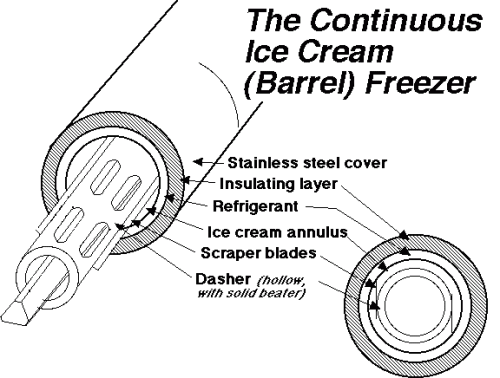Ice Cream Manufacture
7 Freezing/Whipping of Ice Cream
Following mix processing, the mix is drawn into a flavour tank where any liquid flavours, fruit purees, or colours are added. The mix then enters the dynamic freezing process which both freezes a portion of the water and whips air into the frozen mix. The “barrel” freezer is a scraped-surface, tubular heat exchanger, which is jacketed with a boiling refrigerant such as ammonia or freon. Mix is pumped through this freezer and is drawn off the other end in a matter of 30 seconds, (or 10 to 15 minutes in the case of batch freezers) with about 50% of its water frozen. There are rotating blades inside the barrel that keep the ice scraped off the surface of the freezer and also dashers inside the machine which help to whip the mix and incorporate air.

Ice cream contains a considerable quantity of air, up to half of its volume. This gives the product its characteristic lightness. Without air, ice cream would be similar to a frozen ice cube. The air content is termed its overrun, which can be calculated mathematically.
As the ice cream is drawn with about half of its water frozen, particulate matter such as fruits, nuts, candy, cookies, or whatever you like, is added to the semi-frozen slurry which has a consistency similar to soft-serve ice cream. In fact, almost the only thing which differentiates hard frozen ice cream from soft-serve, is the fact that soft serve is drawn into cones at this point in the process rather than into packages for subsequent hardening.

